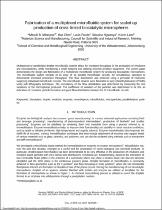 ResearchSpace
ResearchSpace
Fabrication of a multiplexed microfluidic system for scaled up production of cross-linked biocatalytic microspheres
JavaScript is disabled for your browser. Some features of this site may not work without it.
- ResearchSpace
- →
- Research Publications/Outputs
- →
- Conference Publications
- →
- View Item
| dc.contributor.author |
Mbanjwa, M

|
|
| dc.contributor.author |
Chen, H

|
|
| dc.contributor.author |
Fourie, L

|
|
| dc.contributor.author |
Ngwenya, S

|
|
| dc.contributor.author |
Land, K

|
|
| dc.date.accessioned | 2014-08-25T10:15:25Z | |
| dc.date.available | 2014-08-25T10:15:25Z | |
| dc.date.issued | 2014-06 | |
| dc.identifier.citation | Mbanjwa, M, Chen, H, Fourie, L, Ngwenya, S and Land, K. 2014. Fabrication of a multiplexed microfluidic system for scaled up production of cross-linked biocatalytic microspheres. In: Proceeding of SPIE 9257, Sensors, MEMS and Electro-Optical Systems, 92570M, 23 June 2014 | en_US |
| dc.identifier.uri | http://proceedings.spiedigitallibrary.org/proceeding.aspx?articleid=1884907 | |
| dc.identifier.uri | http://hdl.handle.net/10204/7625 | |
| dc.description | Proceeding of SPIE 9257, Sensors, MEMS and Electro-Optical Systems, 92570M, 23 June 2014 | en_US |
| dc.description.abstract | Multiplexed or parallelised droplet microfluidic systems allow for increased throughput in the production of emulsions and microparticles, while maintaining a small footprint and utilising minimal ancillary equipment. The current paper demonstrates the design and fabrication of a multiplexed microfluidic system for producing biocatalytic microspheres. The microfluidic system consists of an array of 10 parallel microfluidic circuits, for simultaneous operation to demonstrate increased production throughput. The flow distribution was achieved using a principle of reservoirs supplying individual microfluidic circuits. The microfluidic devices were fabricated in poly (dimethylsiloxane) (PDMS) using soft lithography techniques. The consistency of the flow distribution was determined by measuring the size variations of the microspheres produced. The coefficient of variation of the particles was determined to be 9%, an indication of consistent particle formation and good flow distribution between the 10 microfluidic circuits. | en_US |
| dc.language.iso | en | en_US |
| dc.publisher | SPIE Digital Library | en_US |
| dc.relation.ispartofseries | Workflow;12620 | |
| dc.subject | Biocatalysts | en_US |
| dc.subject | Droplets | en_US |
| dc.subject | Emulsion | en_US |
| dc.subject | Enzymes | en_US |
| dc.subject | Monodisperse | en_US |
| dc.subject | Microfluidics | en_US |
| dc.subject | Microparticles | en_US |
| dc.subject | Parallelisation | en_US |
| dc.subject | Scaleup | en_US |
| dc.title | Fabrication of a multiplexed microfluidic system for scaled up production of cross-linked biocatalytic microspheres | en_US |
| dc.type | Conference Presentation | en_US |
| dc.identifier.apacitation | Mbanjwa, M., Chen, H., Fourie, L., Ngwenya, S., & Land, K. (2014). Fabrication of a multiplexed microfluidic system for scaled up production of cross-linked biocatalytic microspheres. SPIE Digital Library. http://hdl.handle.net/10204/7625 | en_ZA |
| dc.identifier.chicagocitation | Mbanjwa, M, H Chen, L Fourie, S Ngwenya, and K Land. "Fabrication of a multiplexed microfluidic system for scaled up production of cross-linked biocatalytic microspheres." (2014): http://hdl.handle.net/10204/7625 | en_ZA |
| dc.identifier.vancouvercitation | Mbanjwa M, Chen H, Fourie L, Ngwenya S, Land K, Fabrication of a multiplexed microfluidic system for scaled up production of cross-linked biocatalytic microspheres; SPIE Digital Library; 2014. http://hdl.handle.net/10204/7625 . | en_ZA |
| dc.identifier.ris | TY - Conference Presentation AU - Mbanjwa, M AU - Chen, H AU - Fourie, L AU - Ngwenya, S AU - Land, K AB - Multiplexed or parallelised droplet microfluidic systems allow for increased throughput in the production of emulsions and microparticles, while maintaining a small footprint and utilising minimal ancillary equipment. The current paper demonstrates the design and fabrication of a multiplexed microfluidic system for producing biocatalytic microspheres. The microfluidic system consists of an array of 10 parallel microfluidic circuits, for simultaneous operation to demonstrate increased production throughput. The flow distribution was achieved using a principle of reservoirs supplying individual microfluidic circuits. The microfluidic devices were fabricated in poly (dimethylsiloxane) (PDMS) using soft lithography techniques. The consistency of the flow distribution was determined by measuring the size variations of the microspheres produced. The coefficient of variation of the particles was determined to be 9%, an indication of consistent particle formation and good flow distribution between the 10 microfluidic circuits. DA - 2014-06 DB - ResearchSpace DP - CSIR KW - Biocatalysts KW - Droplets KW - Emulsion KW - Enzymes KW - Monodisperse KW - Microfluidics KW - Microparticles KW - Parallelisation KW - Scaleup LK - https://researchspace.csir.co.za PY - 2014 T1 - Fabrication of a multiplexed microfluidic system for scaled up production of cross-linked biocatalytic microspheres TI - Fabrication of a multiplexed microfluidic system for scaled up production of cross-linked biocatalytic microspheres UR - http://hdl.handle.net/10204/7625 ER - | en_ZA |





